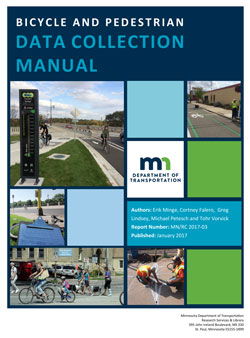As part of an ongoing effort to institutionalize bicycle and pedestrian counting in Minnesota, the Minnesota Department of Transportation (MnDOT) has published a new manual designed to help city, county, state, and other transportation practitioners in their counting efforts.
The Bicycle and Pedestrian Data Collection Manual, developed by University of Minnesota researchers and SRF Consulting Group, provides guidance and methods for collecting bicycle and pedestrian traffic data in Minnesota. The manual is an introductory guide to nonmotorized traffic monitoring designed to help local jurisdictions, nonprofit organizations, and consultants design their own programs.
Topics covered in the manual include general traffic-monitoring principles, bicycle and pedestrian data collection sensors, how to perform counts using several types of technologies, data management and analysis, and next steps for nonmotorized traffic monitoring in Minnesota. Several case studies illustrate how bicycle and pedestrian traffic data can be used to support transportation planning and engineering.
The manual was completed as part of the third in a series of MnDOT-funded projects related to the Minnesota Bicycle and Pedestrian Counting Initiative, a collaborative effort launched by MnDOT in 2011 to encourage nonmotorized traffic monitoring across the state. U of M researchers, led by professor Greg Lindsey at the Humphrey School of Public Affairs, have been key partners in the initiative since its inception.
In addition to the manual, U of M researchers have published a final report outlining their work with MnDOT on this project. Key accomplishments include:
- A new statewide bicycle and pedestrian traffic-monitoring network with 25 permanent monitoring locations
- A district-based portable counting equipment loan program to support MnDOT districts and local jurisdictions interested in nonmotorized traffic monitoring
- Minnesota’s first Bicycle and Pedestrian Annual Traffic Monitoring Report
- A MnDOT website for reporting annual and short-duration counts that allows local planners and engineers to download data for analysis
- Provisions added to MnDOT equipment vendor agreements that enable local governments to purchase bicycle and monitoring equipment
- Annual training programs for bicycle and pedestrian monitoring
- Provisions in the Statewide Bicycle System Plan and Minnesota Walks that call for bicycle and pedestrian traffic monitoring and creation of performance measures based on counts
“This is an excellent resource that steps through all aspects of managing a count program, and I think it will be very helpful to other states and organizations that want to implement their own programs,” says Lisa Austin, MnDOT bicycle and pedestrian planning coordinator. “Since Minnesota is a leader in counting bicycle and pedestrian traffic, it also fulfills what I think is an obligation to share our story with others.”



